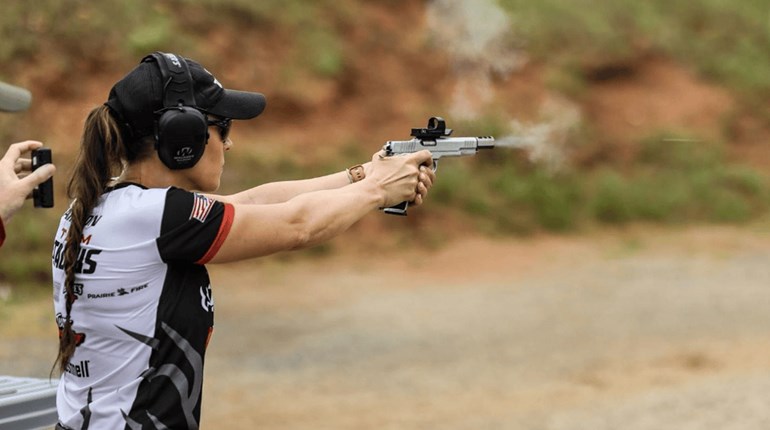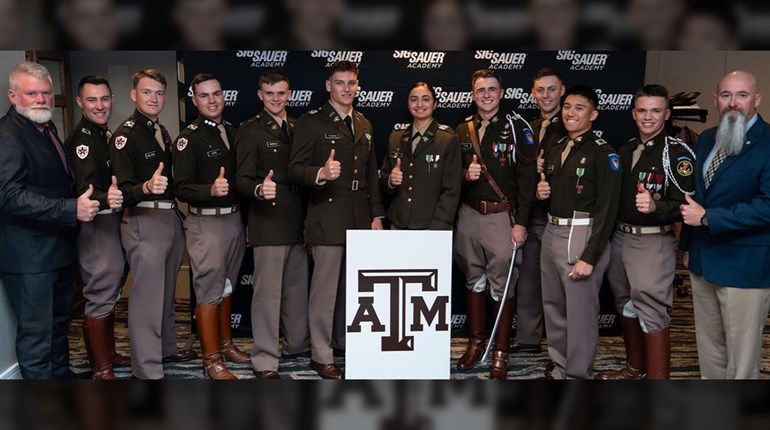
Above: The SIG Sauer P320RX handgun and ROMEO1 reflex sight combo offers a wide window with a generous view of the field, a major aid when rapidly transitioning between multiple targets.
Mounting a compact reflex sight directly to the slide of a semi-auto handgun has become increasingly popular in recent years. Popular enough, that the United States Practical Shooting Association (USPSA) has created a competitive division for Carry Optics in both USPSA and Steel Challenge matches.
During the early years the mounting process involved having a gunsmith machine a slide to accept the sight. Recently, a number of gun makers have begun offering guns machined from the factory to allow the mounting of several popular brands of reflex sights. In 2016 SIG upped the ante with the introduction of their new P320RX—a factory pistol shipped with a reflex sight already mounted, and ready for the range.
The gun
The pistol is the full-sized version of SIG’s P320, chambered for 9mm and wearing a SIG ROMEO1 reflex sight. In addition to the reflex sight the P320RX features suppressor-height SIG tritium night sights that are drift adjustable for windage and visible through the reflex sight window.

The gun has a 4.69-inch barrel, an overall length of 8.05-inches, and with the ROMEO1 installed the weight with an empty 17-round magazine is about 29 ounces. The barrel uses the proven 1:10 twist rate with 6-groove rifling. Like the rest of the P320 family it incorporates a stainless steel inner frame assembly, a stainless steel slide with a Nitron finish, and a polymer grip frame that includes a Picatinny rail on the dust cover. The polymer grip module features stippling on side panels, front and backstraps. Left side controls consist of a slide release, take down lever and a magazine release that is reversible to the right side.
The gun does not have a magazine safety, which will please most competitors. For cleaning, simply remove the magazine, check the chamber and lock the slide back. Turn the take down lever down, pull slightly back on the slide to drop the slide stop, and the upper unit slides off the front. Nothing fancy is required.
The trigger is a partially pre-tensioned striker fired system. SIG specifications call for a trigger pull weight between 5.5 and 6.5 pounds. My trigger pull gauge showed the test gun was right at 6 pounds, with a very short take up and minimal creep.

The P320 series was originally designed as a service duty pistol. Those guns always find their way onto Action Pistol ranges—this is the same gun that SIG Team Captain Max Michel used (in the iron sight version) to win the Production Division at the 2016 Steel Challenge Nationals—setting a new World Record on the “Smoke & Hope” stage in the process. With a 6.86 second overall score, his average time to hit the five targets on each of the four scored runs was 1.715 seconds—from a holstered draw! The P320 can run.
The ROMEO1 sight
The ROMEO1 is a 1x30mm, 1x magnification, compact red dot reflex sight. It operates on a single, readily-available, CR1632 battery. The battery installs from the top of the sight and does not require removing the sight from the gun to replace the battery. Elevation and windage adjustments are made with calibrated adjustment dials (elevation on top and windage on the right side). The graduated, marked, adjustments are in 1 MOA increments. The LED dot measures 3 MOA and offers four daylight brightness levels and one night NV setting.
Whomever designed this sight has obviously spent a lot of time on action shooting ranges because the operating procedures are simple, direct, and positive.

The only ‘operating controls’ on the sight are a pair of left side buttons—one green arrow pointing up, and another pointing down. To turn the sight ON, momentarily depress either button. Press the DOWN arrow to reduce dot brightness and the UP arrow to increase it. To turn the sight OFF, depress and hold either button for two seconds. When the sight is turned back on it will automatically return to the last power setting selected. For those shooters who turn their dot ON in the Make Ready phase and OFF in the Unload and Show Clear phase, it doesn’t get any easier. There is also an included plastic lens cover that snaps on and off to protect the lenses from the inevitable dust and airborne debris common on any range.
Another nice feature is the automatic ‘Power Saving’ mode. If there is no movement of the gun for a two-minute period the sight will automatically turn off to save battery power. The first movement of the gun turns it back on to the previously selected power setting. I actually timed this by laying the gun on a table with a stop watch and the two-minute turn off was dead on. Picking up the gun immediately turned the sight back on. This is of little advantage on the range, or the drive home, because normal body and vehicle movements will keep the sight on. But if you forget to turn off the sight and then put the gun up until the next match you won’t have a dead battery—a handy feature for the forgetful!

The dot is 3 MOA. Many action shooters (this one included) prefer a larger dot size. But this dot is very bright! It actually looks bigger than the specifications indicate and I had to turn it down to the number 2 power setting for the accuracy tests to avoid ‘dot bloom’. During a Steel Challenge match I did set it to full power and it performed well on 10 12-inch plates at 20 yards, and was more than bright enough for closer plates. The ‘sight window’ on the ROMEO1 is larger than those on the three reflex sights I have on my competition guns, and I liked that for the rapid transitions required in Steel Challenge.
Something else that impressed me was that the mounting screws that secure the ROMEO1 to the slide are sturdy 1/8-inch hex heads—instead of the skinny little 1/16-inch hex screws used by some other makers. I have stripped a few of those 1/16-inch screw heads and needed a machine shop (and some money) to get that screw out. That’s not likely here, making shifting between the reflex sight and iron sights simple and trouble free.
On the range

I started by zeroing the ROMEO1 from a sandbag rest at 25 yards. The adjustments were quick and positive, and the included small screwdriver made the process easy. The smoothly-radiused trigger was very comfortable, and the stippled grip module provided a positive hold. I had a variety of factory loads that included 115-, 124-, and 147-grain projectiles. I also included my Steel Challenge “mouse puff” (116.5 PF) handload that sends a 124-grain coated Bayou bullet out the muzzle at about 940 fps. Some guns won’t handle that load unless a lighter recoil spring is installed, but the SIG ran them easily.
Accuracy tests were next, and they were a very pleasant surprise! I consider “decent” semi-auto service pistol accuracy to be in the 2.5- to 3-inch range. The SIG exceeded those expectations by a noticeable margin, as the accuracy chart below shows.
Once that was done I ran the various loads through multiple target drills, and there was not a single malfunction in the 300-plus rounds, including the Bayou handload. That was followed by a 150 round Steel Challenge match, and no malfunctions there.
The SIG P320RX ships in a hard plastic box with two 17-round magazines, instruction manuals for both the gun and sight, a lens kit that includes the snap-on cover, a screwdriver that handles the sight adjustment and the battery compartment, a lens cleaning cloth, and a 1/8-inch hex wrench to remove and reinstall the sight; which can quickly make it a legal gun for USPSA Production or Limited, and IDPA in both SSP and ESP divisions. Or, a 17-round night sight-equipped home defense arm. That’s a lot of versatility for one gun! MSRP: $886.


































